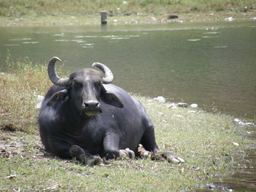Today we obtained some interesting insights as to some of the social dimensions and belief systems of Nepal, some of which directly relate to agricultural practices in this country. Perhaps the most interesting of these is the belief that cattle are sacred, divine creatures in Hinduism. As such, Nepalis revere these animals and do not consume any sort of beef. Cows are raised for milk, while bulls and steer provide labor for tilling fields. It is, in fact, illegal to kill cattle, and doing so can land you in jail in Nepal! Cattle roam free throughout Nepal – whether in the countryside or in the cities – and any sort of mistreatment of cattle can get you into serious trouble. This leads to some slightly controversial issues in terms of veterinary medicine and productivity. First of all, the ban against killing cattle extends to euthanasia: even if a cow is suffering greatly with exceptionally poor prognosis, Nepalis will not euthanize that cow – instead, they will provide as much supportive care as possible, and let the animal die naturally. Similarly, cows cannot be killed even if there is an outbreak of some sort of devastating, contagious infectious disease. At best, cattle can be quarantined in such a situation. Similarly, the concept of culling cattle is much more limited compared to that used in the States. A cow will not be culled for poor productivity or infertility. At best, an owner can sell a cow that is a poor performer, but that is about it. 
The counter to this view of cattle is that of the water buffalo. If cattle are considered divine, water buffalo are considered demonic, even if they are closely related to cattle. As such, water buffalo is one of the most commonly consumed meats in Nepal, along with goat and chicken meat. It is said that dreaming of water buffalo constitutes an ill omen. They provide meat, milk, manure and labor, yet are not held in anywhere near as high esteem as cattle. 
Another concept we learned about is the caste system. Although it is not alive as much as it was in the past, it still permeates much of Nepali society. The higher castes and the lower castes have very specific interactions (or perhaps lack thereof): a high caste person is “polluted” if touched by a low caste person, and would not accept food or water prepared by one of them. Similarly, if a low caste man marries a high caste woman (which is very unlikely), that woman goes down in status to that of the low caste husband. Caste is depicted in everything from features (high caste features people with large, prominent noses for example), to name, to manner of dress (the national hat, for example, is worn differently depending upon caste). There is even a quota system – sort of like affirmative action – for low caste members in public schools.
Lauren and I somehow managed to be pronounced of the high caste based on our physical features. Yoon, who is Korean of Mongolian origin and has a small nose, was emphatically declared to be of the low caste, to his great disappointment!


Leave a comment
Comments feed for this article